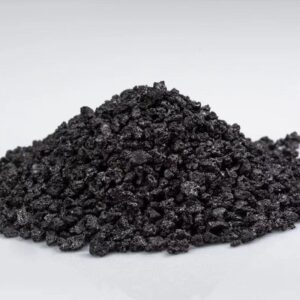Struggling with inconsistent carbon recovery or slag issues in your foundry? You're not alone—many operations face these costly inefficiencies.
Graphite Petroleum Coke (GPC) is widely used in foundries due to its high fixed carbon content, low sulfur, and excellent absorption rate, making it one of the most effective carbon raisers for clean and stable molten metal.
Let’s explore why GPC is the go-to recarburizer for modern foundries—and how it compares with other carbon sources.
What is Graphite Petroleum Coke and How Is It Made?
Wondering what sets GPC apart from regular petroleum coke or anthracite? The answer lies in its structure.
Graphite Petroleum Coke is a byproduct of oil refining that’s been further heat-treated at high temperatures (2800–3000°C) to transform into graphitized carbon. The result is a highly pure, crystalline carbon additive ideal for metallurgy.
GPC vs Raw Petroleum Coke
| Property | GPC | Raw Pet Coke |
|---|---|---|
| Fixed Carbon | ≥98.5% | 85–90% |
| Sulfur | ≤0.05% | >1% |
| Ash | ≤0.7% | 2–4% |
| Volatile Matter | ≤0.8% | 10–15% |
| Cost | Higher | Lower |
GPC offers far superior purity and reactivity, which means more efficient carbon uptake and fewer contaminants in the melt.
For more details on GPC grades, see our Graphite Petroleum Coke product page.
Why is GPC Preferred for Ductile and Gray Iron?
Foundry-grade GPC isn’t just cleaner—it’s essential for critical casting applications.
In ductile and gray iron production, low sulfur and high fixed carbon are non-negotiable. That’s why foundries increasingly prefer GPC over kalsine antrasit kömürü or traditional coke-based carbon raisers.
GPC Benefits for Iron Casting
- Low Sulfur (<0.05%) – Prevents undesired reactions in molten iron.
- High Absorption Rate – Fast melting and consistent carbon recovery.
- Low Ash – Reduces slag and improves melt fluidity.
- High Carbon Recovery – Often >95% when added properly.
Many of our customers switched from calcined petroleum coke to GPC and reported better casting consistency, especially in thin-wall components.
When Should You Use GPC Over Other Recarburizers?
Choosing between GPC, CPC, and anthracite depends on your furnace, product quality goals, and budget.
Here’s a quick guide:
| Application | Recommended Recarburizer |
|---|---|
| Ductile Iron | GPC or Artificial Graphite |
| High-Strength Gray Iron | GPC |
| Carbon Steel | GPC / CPC |
| Budget Foundry Melt | Calcined Anthracite |
For high-end casting where sulfur and ash control is critical, GPC offers unmatched performance.
Explore our TBM page if you're comparing options.
How to Use GPC for Best Results in Foundry Operations?
Even with high-quality GPC, your results depend on how you use it.
Best Practices:
- Add Early in Melt – GPC absorbs better when the bath is turbulent.
- Preheat if Moist – Ensure material is dry to avoid foaming.
- Use 1–5mm or 2–6mm Size – Best for induction and electric furnaces.
- Avoid Overuse – Adding too much increases slag and cost.
We recommend testing different mesh sizes—our foundry clients in Europe often prefer 1–5mm for gray iron and 2–6mm for ductile iron.
What Makes GPC a Long-Term Cost Saver?
While GPC may cost more upfront, it saves in:
- Lower Rejection Rates
- Reduced Slag Handling
- Shorter Melting Time
- Consistent Chemistry = Fewer Corrections
One Southeast Asian ductile iron foundry cut their correction rate by 30% after switching to our high-purity GPC. They recovered their investment in less than one month.
Çözüm
Graphite Petroleum Coke offers unmatched purity, efficiency, and reliability in foundry applications—making it the smart choice for quality iron casting.
Call to action
Looking to improve your casting quality and carbon efficiency?
📧 Email: [email protected]
📞 WhatsApp: +86-18202528603
Let us help you choose the right GPC grade and size for your foundry needs—fast delivery, low MOQ, expert support.


